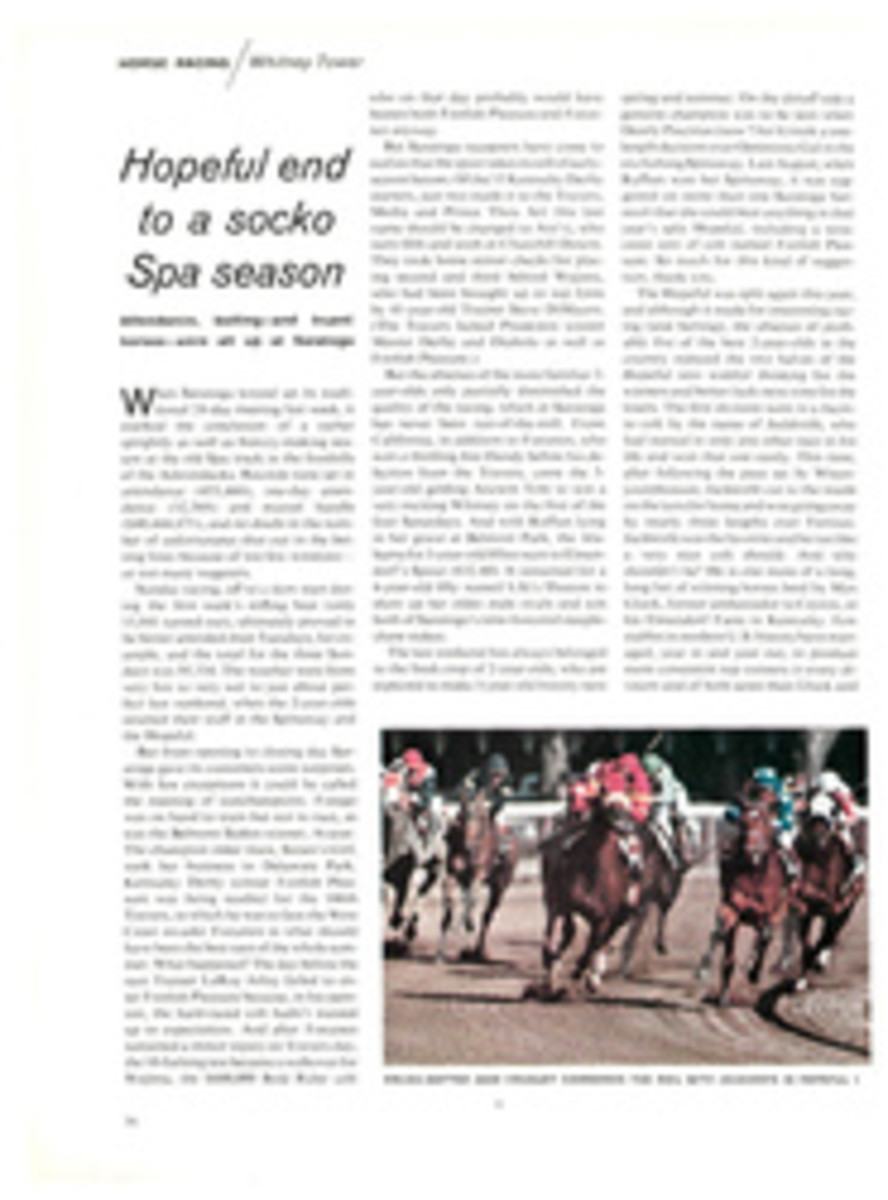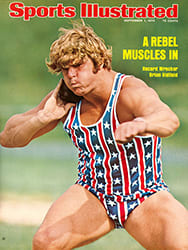
Oh, that 200-yard run!
In 1949, the year I went to work for the Los Angeles Rams as an assistant publicity director, Norman Van Brocklin was a rookie quarterback. He was paid a $750 bonus for signing and his salary was $12,000 a year. He was probably the NFL's highest-paid rookie.
Now, a little more than 26 years later, the Dutchman is in temporary retirement, I am only a few days away from retiring from SPORTS ILLUSTRATED and Joe Namath has signed a new contract with the Jets for $450,000 a year. That is only a little less than the Rams lost during the 1949 season.
Van Brocklin was one of the five best quarterbacks I have ever seen; Namath was superb for two years and may be again, but even in these inflationary times he is not worth 30 or 40 times more than Van Brocklin was.
Since I feel that ticket prices are already too high and TV revenue is probably approaching the maximum, it seems to me the only way for many clubs to survive is by cutting salaries. This won't affect the game. Over the past 26 years the quality of play has been diluted as a direct result of the increase in the number of teams.
In 1950, there were 13 professional football teams, 32 players per team, a total of 416 of the very best players. In 1975 there are 37 teams, with 38 and 43 players per team for a total of 1,536 players. The colleges are not producing significantly more qualified players, so 1,120 of these men would not have made a pro football club in 1950.
There are as many stars as ever, but they are spread more thinly. The Dolphins dominated the league with five or six; when the Packers were in their prime they had 10 or 12, and when the Rams played the Browns in the 1950 championship game, both teams had starting lineups comprised almost completely of players who would be stars today.
The Cleveland quarterback was Otto Graham; the Rams had All-Pro Bob Waterfield and All-Pro-to-be Van Brocklin. The wide receivers were Mac Speedie and Dante Lavelli for the Browns and Elroy Hirsch and Tom Fears for the Rams. With the exception of Speedie, all are in the pro football Hall of Fame. Running backs? Dub Jones and Marion Motley for the Browns; Glenn Davis, Vitamin Smith and three 225-pound fullbacks, Dick Hoerner, Dan Towler and Tank Younger, for the Rams.
The total payroll for the Browns and the Rams—per team—was probably less than Namath's $450,000. And there were three quarterbacks in the game who over their careers were better than Namath.
It was the best football game ever played—better than the 1958 Colts-Giants title game—the Browns winning 30-28 in the last 28 seconds on a Lou Groza field goal. The score is another indication of what has gone wrong with pro football since then.
In that game super players played against super players head to head. All the coverage was man to man. The Rams had averaged almost 40 points a game that year. They gave up more than 25 points per game because, head to head, a great receiver will more often than not beat a great defensive back. The receiver knows where he is going and how he is going to get there—the defensive back can only react, a split second later. Given passers like Graham, Waterfield and Van Brocklin, the receiver—if he is a Fears, Hirsch, Speedie or Lavelli—will win the duel.
Great receivers will beat the zone coverage that is prevalent today, but not deep and not often. One of the most pleasant memories I have of pro football is Elroy Hirsch going down the sideline, and 60 yards downfield taking a pass over his head from Waterfield or Van Brocklin, a couple of steps ahead of the defensive back, the ball dropping in on a dime, the back well beaten and Hirsch gone for the touchdown. At $18,000 a year.
Hirsch, Raymond Berry and Tom Fears were the best receivers, for different reasons. Hirsch had everything: extraordinary speed, the best moves I have seen, hands like a glue pot and eyes in the back of his head. Fears had everything Hirsch had except speed. Berry did not have much speed, but he had hands and head and desire, and he spent so much time working at his job that he overcame his handicap.
Incidentally, Fears made the best run I have ever seen. Two of the best, actually. He may have been the most reliable pressure player of all time. The first one was against the Bears in a divisional playoff. He caught a dink pass just over the line of scrimmage from Waterfield. The Bears had 14 shots at him on the tortuous shifting run he made for the touchdown.
The other great run was in the 1951 championship game against the Browns, when he caught a pass between Tom James and Cliff Lewis, the safetymen, and went 73 yards for a touchdown that won that game. Fears was not as fast as either James or Lewis—except on that play.
To go back to the quarterbacks, the five best were, in order, Van Brocklin, John Unitas, Bart Starr, Waterfield and Fran Tarkenton. Technically Otto Graham was as good as any of them, but he never directed a team. His coach, Paul Brown, called the signals.
The keys to judging quarterbacks are the teams they beat, when they beat them and how many games they won. Namath has most often beaten teams with less than a .500 average. Van Brocklin beat good teams when he had to beat them, as did Waterfield, Unitas, Starr and Tarkenton.
The best running back who ever lived was Jim Brown. He may have been something less than the best man who ever lived, but he could carry a football farther and better than anyone.
He played at 6'2" and 228 pounds, but he ran with the speed of O. J. Simpson and he never got hurt. He had an odd gliding stride, his feet never far off the ground and, after he retired, he told me that his stride accounted for his not being injured.
"I never took the impact of a tackle on one leg," he said. "When I got hit I could plant both feet so I didn't get any knee injuries. You read about high knee action for a running back, and that's a lot of bull. You lift your knees high, and there's only one knee takes the shot and something has to go.
Lenny Moore, who played for the Colts, was nearly as good as Brown, and he ran with his knees coming up to his belly button, and he didn't get hurt that much. Hugh McElhenny, the old 49er, combined the two styles. He was probably the most exciting runner to watch. His biggest asset was his ability to change direction without loss of speed. He had Brown's glide and Moore's ability to step over tacklers, and his own sixth sense which warned him of trouble. If by some magic I could see one run again I'd like to see McElhenny's dramatic run against Detroit in the 1957 playoff game between the 49ers and the Lions.
He crossed the field three times, sometimes stopping to let tacklers pass in front of him, turning against the grain in a split second, accelerating to pull away from a tackle and, once, bulling over a tackier. He ran 71 yards downfield, but his total yardage was about 200. He was finally forced out of bounds, exhausted, on the Lion nine-yard line. It was a lovely thing to see.
Sure, O.J. is a super running back and Larry Csonka is a tank, but O.J. does it on speed and Csonka on strength. Brown and Moore and McElhenny did it on strength and speed and finesse. They were more fun to watch.
It is hard to pick out offensive linemen, those anonymous players, but I will always remember the Packer pulling guards—Fuzzy Thurston and Jerry Kramer. They were the most visible of all offensive linemen and the animating force behind—or in front of—the Green Bay power sweep that made Jim Taylor and Paul Hornung All-Pros. The Green Bay offensive line was probably the best ever put together, and the best individual performance was Forrest Gregg's against Deacon Jones in the 1967 conference championship with the Rams. In that game Gregg shut out the fearsome Deacon.
"We had to make him shy about getting in on Starr," Gregg said after the game. "I blocked him aggressively and we ran at him at first. So on the sweeps I took him head-on until he began to hesitate on the pass rush. Then when we started to throw and he started to come, I knew his routes, but he didn't come with reckless abandon, which is the thing he does best. So I could handle him. I was lucky it all worked out."
Deacon and Gino Marchetti were the most capable defensive ends, and very few tackles handled Deacon the way Gregg did on that cold afternoon in Milwaukee; even fewer ever handled Marchetti, who was bigger than the Deacon.
Gino was smart, too. I don't remember any really good pro football players who weren't. Gino is now a multimillionaire with a chain of drive-in restaurants, but while he was playing he had an undeserved reputation as a dummy, probably engendered by Art Donovan, who was a defensive tackle during Baltimore's championship years.
Once, while the team was riding the bus in from the San Francisco airport, Art pointed out the University of San Francisco campus to the players.
"That's where Gino went to school," he said in his oddly high voice. "When he graduated they retired his grades."
Art was a fine defensive tackle, but I think the best were Bob Lilly of the Cowboys and Mean Joe Greene of the Steelers.
Linebackers? There is no way to choose among Ray Nitschke, the old Packer, Tommy Nobis of the Falcons and Dick Butkus of the Bears in the middle. The quickest and toughest corner linebackers were Ted Hendricks, now with Oakland, and Dan Currie, another Packer. But you could make a good case for Dave Robinson of the Packers and Pittsburgh's Jack Ham.
Willie Wood, the new coach of the Philadelphia team in the WFL, and Emlen Tunnell, who died not long ago, were the best safeties; Herb Adderly and Night Train Lane were the best cornerbacks.
But, of course, all of this is subjective. Maybe the players I think were the best happened to have good days when I saw them; another observer could come up with an entirely different set of players and his choice would be just as valid.
I think the game has slowed down; somehow, it has to get back to the old concept of man on man. From time to time, I have offered suggestions on how to get rid of zone defenses, but the zones are still with us and probably will be as long as coaches follow their conservative ways.
It doesn't make that much difference, really. The game is here to stay and it lives on players, not rules.
There will be as many great players in the next 26 years as there were in the last.
I hope I get to see them.
PHOTO
VAN BROCKLIN, THE BEST QUARTERBACK
PHOTO
JIM BROWN, THE BEST RUNNER OF ALL

